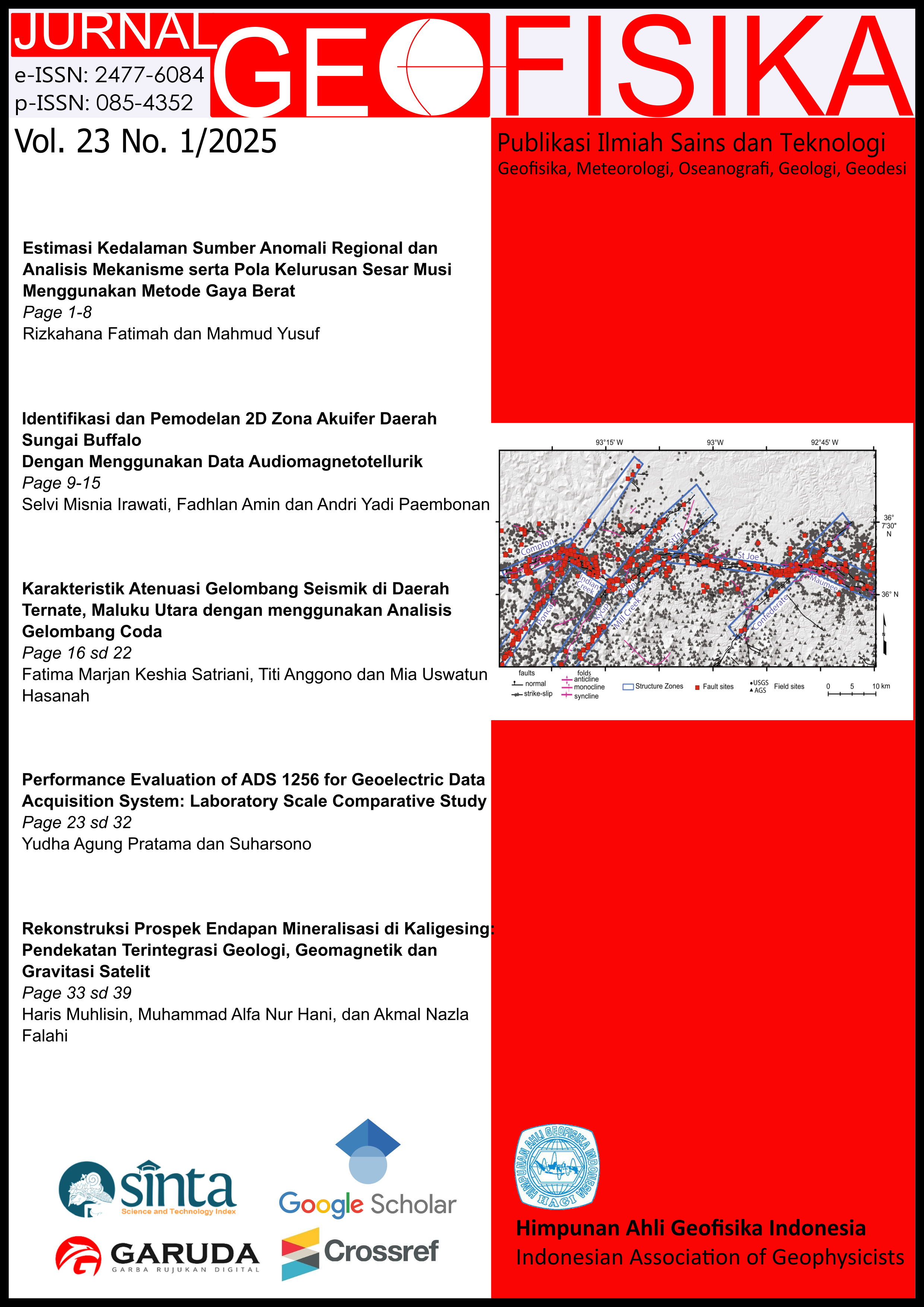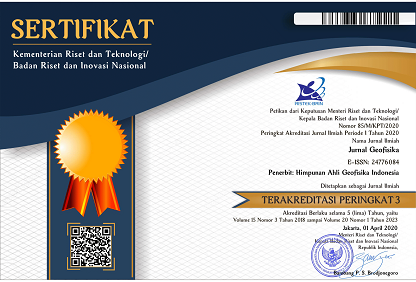Estimasi Kedalaman Sumber Anomali Regional dan Analisis Mekanisme serta Pola Kelurusan Sesar Musi Menggunakan Metode Gaya Berat
Keywords
SBA, Musi fault, FHD, SVDAbstract
Musi Fault is one of the segments of the Semangko Fault (Great Sumatra Fault) that triggered the M6.0 Curup earthquake on December 15, 1979. Until now, the Musi Fault is still recorded as an active fault with a slip rate of 13.5 mm/year. The location of the Musi Fault is at 102.2º East - 102.9º East and 3.2º East - 3.9º East. This region is a part of a growing tourism industry, while there are risks due to seismic activity and seismicity in the region. Therefore, it is necessary to analyze the gravity in the Musi Fault area. This study aims to determine the estimated depth of the regional anomaly source zone based on the results of spectrum analysis. Then, derivative analysis is also carried out to identify the mechanism and location of faults so that a picture of the alignment pattern of the Musi Fault can be obtained. The method used in this research is the gravity method using data from GGMplus, Batnas, Demnas, and other supporting data used to validate the analysis results. The spectrum analysis results show that the estimation of the regional zone depth reaches 1,366.8 meters and the residual zone depth reaches 128.69 meters. The results of derivative analysis using Surfer 14 are displayed in a curve to obtain the fault location boundary which is then displayed in a map showing that the Musi Fault has a northwest - southeast alignment pattern. The fault mechanism is dominated by shear faults and there are several points that tend to be oblique. The analysis results are in accordance with previous studies, which state that the Musi Fault has a strike slip mechanism.
References
pengukuran fotogrametri. JRST (Jurnal Riset Sains dan Teknologi), 6, 23–31,doi:10.30595/jrst.v6i1.10769.
Amin, T., Pardede, R., Amin, T. Gafur, S. (2007): Peta geologi lembar bengkulu, sumatera: Geological map of the
bengkulu quadrangle, sumatera.
Blakely, R.J. (1995): Potential Theory in Gravity and Magnetic Applications. Cambridge University Press.
Hidayat, W. Giamboro, W. (2019): Analisis continuous wavelet transform (cwt) anomali residual medan gravitasi
di situs geologi karangsambung kebumen jawa tengah. Jurnal Mineral, Energi dan Lingkungan, 2, 61,
doi:10.31315/jmel.v2i2.2368.
Hurukawa, N., Wulandari, B.R. Kasahara, M. (2014): Earthquake history of the sumatran fault, indonesia, since
1892, derived from relocation of large earthquakes. Bulletin of the Seismological Society of America, 104(4), 1750–1762, ISSN 0037-1106,doi:10.1785/0120130201.
Lubis, A., Butarbutar, D., Suhendra, S. Samdara, R. (2019): Investigasi sudut pergerakan sesar di segmen musi
kepahiang dengan menggunakan metode geolistrik. Jurnal Meteorologi dan Geofisika, 20(2), 67–72.
Margiono, R., Novitri, A., Pevriadi, A. Zakariya, H. (2022): Analisis data gravitasi untuk identifikasi sesar lokal penyebab gempabumi di wilayah barat daya sumba indonesia. Jurnal Meteorologi dan Geofisika, 22(2), 67–73.
Mase, L.Z., Refrizon, R., Pakpahan, N.S., Shelina, A., Wu, J. Chaiyaput, S. (2024): Site characteristics of musi fault
zone in kepahiang urban area, bengkulu province, indonesia. Transportation Infrastructure Geotechnology,
11(4), 2453–2482, ISSN 2196-7210,doi:10.1007/s40515024-00375-w.
Natawidjaja, D.H. (2018): Updating active fault maps and sliprates along the sumatran fault zone, indonesia.
IOP Conference Series: Earth and Environmental Science, 118(1), 012001,doi:10.1088/1755-1315/118/1/012001.
Novianto, A., Hidayat, W. Bintarto, B. (2025): Interception of meratus and java trends structures as controlling the emergence of the purwodadi mud volcano complex. IOP Conference Series: Earth and Environmental Science, 1458(1), 012018,doi:10.1088/1755-1315/1458/1/012018.
PUSGEN (2022): Peta Deagregasi Bahaya Gempa Indonesia untuk Perencanaan dan Evaluasi Infrastruktur Tahan
Gempa. Kementerian Pekerjaan Umum dan Perumahan Rakyat, Bandung, ISBN 978-602-5489-44-0.
Rivandi, A., Destawan, R., Fajri, Z.R. Hidayat, W. (2016): 3d geothermal modelling using gravity survey on dolok
marawa, simalungun district, north sumatera. IOP Conference Series: Earth and Environmental Science, 29(1),
012011,doi:10.1088/1755-1315/29/1/012011.
Rosenbach, O. (1953): A contribution to the computation of the second derivative from gravity data. Geophysics,
18(4), 894–907,doi:10.1190/1.1437943.
Sarkowi, M., Wibowo, R. Yogi, I. (2022): Potensi gempabumi di sepanjang sesar semangko segmen lampung. Jurnal Teknologi dan Inovasi Industri, 3(2), 27–33, ISSN 2722018.
Sumintadireja, P., Dahrin, D. Grandis, H. (2018): A note on the use of the second vertical derivative (svd) of gravity
data with reference to indonesian cases. Journal of Engineering and Technological Sciences, 50(1), 127–139,
doi:10.5614/j.eng.technol.sci.2018.50.1.9.
Telford, W.M., Geldart, L.P. Sheriff, R.E. (1990): Applied Geophysics. Cambridge University Press, 2nd edn.

This work is licensed under a Creative Commons Attribution 4.0 International License.
The copyright of all articles belongs to the authors. All other copyrights is held by the Journal











